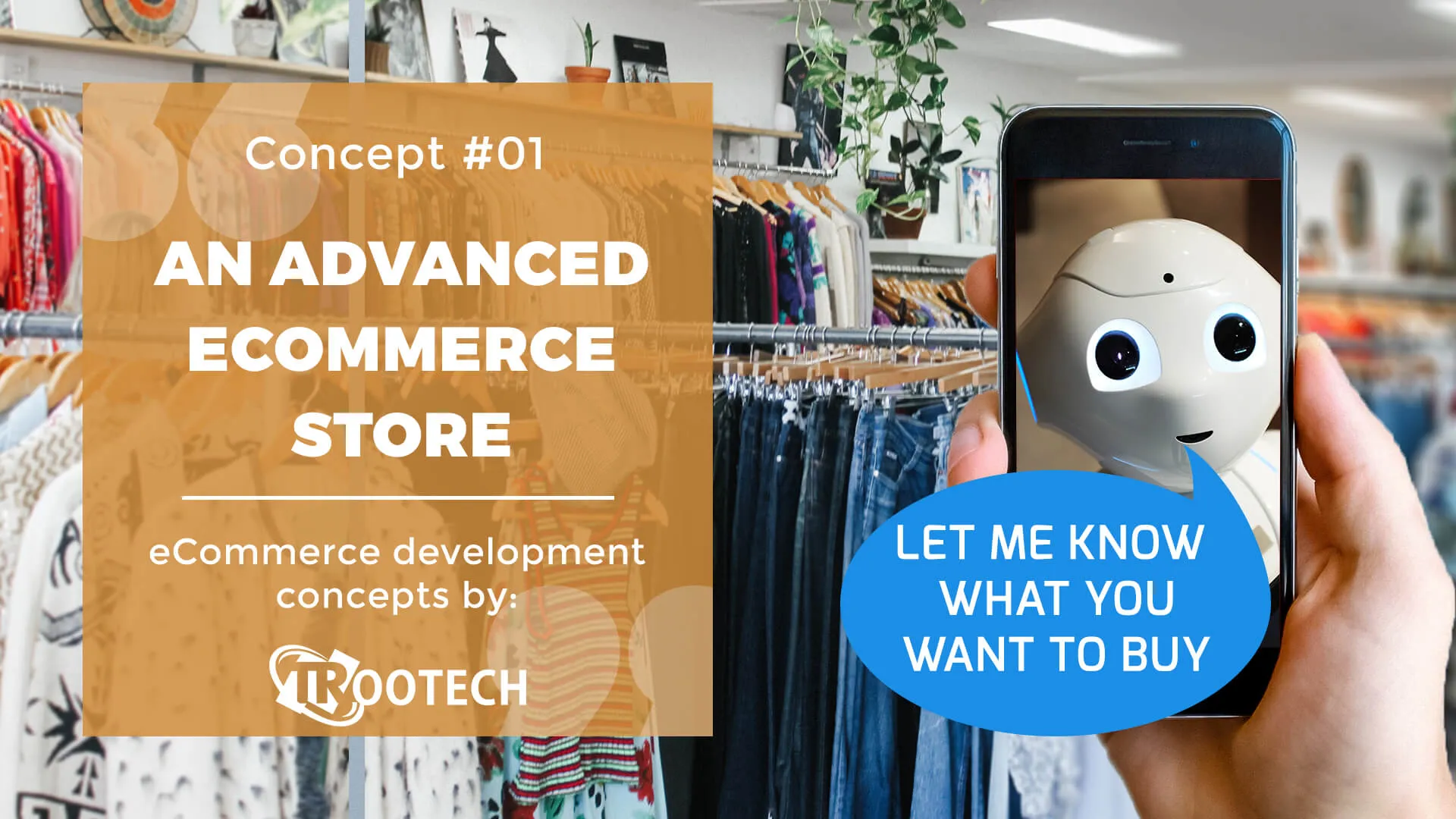Online Shopping – Not so old but worth much more!
It was in the year 1991 that online shopping took it’s first baby steps. It took three years, 1994, for the internet to gain popularity among the general public.
Add four more years and the first security protocols, like HTTP and DSL developed allowing persistent connection to the internet.
This laid the foundation for one of the largest ecosystems that exist on the world wide web today–eCommerce.
Within no time, by the end of the year 2001, the largest form of eCommerce, B2B (Business-to-Business) model contributed $700 billion in transactions.
Today, eCommerce generates $1.2 million every 30 seconds.
Then can you imagine, what the Use of AI in eCommerce can do for you?
From beginning of an online era to use of AI in eCommerce
eCommerce has been through a lot of changes since its inception. Every new technological advancement brought in wind of change in eCommerce development and marketplaces.
Websites and Web applications have now become more secure than they used to be.
Almost anything today can be bought online–almost everything under the sun is available to buy online.
From personalization to checkout experience, from augmented reality to ML powered suggestions, eCommerce has tasted every bit of new technology that is out there and now is the time for the use of ai in eCommerce.
Similar to a physical store, a user goes through what we call a ‘buyer’s journey’ online.
Just as in a physical store a buyer would explore different aisles or sections, search for items of their preference, sizes, color etc and end up the billing desk with their choice of products, an online customer also goes through the similar process.
This is how a typical buyer’s journey looks like.

Stage 1 Awareness:- The initial stage where a user is aware of their problem, opportunity, necessity, desire or need. A user knows grocery supplies are about to run out and they will need to refill the month’s supplies sooner. This is user awareness stage.
Stage 2 Consideration:- The second phase of the journey where the user now considers all available options. Now that user is aware that they need groceries, they look for all the possible sources from where they can make the purchase.
Stage 3 Decision:- This is where the user decides what they will buy and from whom they will buy it. The user has made the decision and will now choose the business they want to engage with.
This is the buyer’s journey from a business’s perspective. The design is to target users at different stages with various techniques to capture their attention.
But, what is the buyer’s journey from the buyer’s perspective themselves? Today, a typical buyer experiences what it’s called, Analysis Paralysis.
With too many choices, categories and options to choose from, a typical buyer cannot decide on what to buy or choose from the rest of the options.
Like a physical shopping mall, there are tons and tons of stores online for a single category of product.
To understand this, let’s take up a few examples.
Amazon, the eCommerce giant, sells more than 2,000 types of just ‘soap dishes’. This explains why it sells more than 480 million products in the USA alone.
Newegg, computer hardware and consumer electronics marketplace, has over 26 million products on its website.
Macys.com, an online departmental store, offers millions of products ranging from clothing, accessories, jewelry, furniture, bed & bath etc.
Now, looking from a single consumer’s point of view, these stores are surely going to overwhelm her.
Imagine, whenever she visits the website or opens the app, instead of coming to a decision, she goes into a downward spiral of clicking on every visually appealing product or category. And the next thing she knows, she has wasted more than an hour just surfing around the online store without picking a single item; coming back to where she started.
Stores like these have done a commendable job of segmenting hordes of products under a cleverly defined limited number of categories to avoid choice paralysis for users.
Alas! Sometimes, when presented with millions of choices around them, it gets the better of the consumers.
What could be the best solution to this? Is there a way to get out of the choice paralysis vortex?
Let us dive in further to find out.
Best eCommerce Platforms – Best Friend to Your Online Store
Building an online store today is simpler than it ever was. To oversimplify, it requires just a few clicks to start an online store and make it live.
There are some reputed eCommerce platform services today which eases the work for someone who wants to start an online store.
Shopify, Volusion, BigCommerce are a few of the most preferred eCommerce platforms to build an online store on.
As of mid-2017, Shopify had more than 500,000 stores, across 175 countries, thriving on its platform.
BigCommerce serves in more than 120 countries and has generated more than $17 billion in merchant sales.
What makes these platform so desirable among the customers?
Shopify:- Along with responsive and wonderful themes, one of the most prominent features of Shopify is their Point-of-sale (POS) kit. This gives the ability to accept credit cards in-store, on the go, and everywhere.
A merchant can sell their products in-store or at any physical location as far as their inventory is in sync with their online Shopify store.
A POS kit from Shopify contains a card reader, barcode scanner, cash drawer and receipt printer. Whenever someone shops in-store or at a physical location with say for example a card, the card-swipe dock provided by Shopify seamlessly updates the data on the online store.
Shopify also handles the creation and application of product categories exceptionally well.
Hence, stores build on this platform tend to look neat to its consumers.
BigCommerce:- One of the most considerable features for BigCommerce is the way it handles product variants and advanced product filtering.
BigCommerce’s ‘product options’ and ‘product rules’ allows creating a very large number of product options enabling visitors to search the store using custom fields. Hence, if someone is selling products from a wide range of selection, BigCommerce’s product filtering option can be very useful.
This lets users easily find their desired product strategically categorized under various sections.
Similarly, Volusion is also one among the preferred platforms for its category management system, website builder templates etc.
Here is the summary of all the features that are significant for an online store:
- Reporting
- Shipping & Handling
- Returns
- Payment Gateways
- Shopping Cart
- Checkout optimization
- Conversion Rate Optimization
- Product Catalog Management
- Landing Page Conversion
- Product listings and descriptions
- Product Image optimization
- Easy checkout process
- Product quick view
- Reviews and ratings
- Product recommendation
- Social sharing and recommendation
- Page design and theme
- ‘Buy’ button for various channels
- Faster load times/AMP
- Optimized website across all devices
- Omnichannel support
- Customer support and Contact us pages
All of these factors combined make a decent eCommerce website.
Each user interacts differently with a website; their behavioral patterns cannot be predicted. Hence innovators try to include those elements which cater to a wide variety of needs.
Let us look in more detail what this means.
Users of eCommerce websites & their Browsing Patterns
Whether or not the use of AI in eCommerce is done, the type of shoppers remains the same. As discussed, you can never predict the type of shopper that will land on a website.
However, various studies, research, surveys, and focus group sessions have allowed researchers to identify five main types of shoppers that exist today.
- Browsers or Surfers
- Researchers or Explorers
- One-time Shoppers
- Bargain Hunters
- Product Focused
Browsers or Surfers
__________

Browsers feature first in the list since they are not potentially ‘shoppers’. They may or may not buy things, you can never know.
Browsers are the most curious people out there. They know what’s on the internet, what websites are offering discounts, which websites have a wide range of products, every bit of this data is stored at the back of their mind.
There can be either of the two cases here,
A) They know about your website or the app and they chose to spend time on it, or
B) They were just surfing the internet and stumbled upon your website by chance.
In both the cases, however, there lies a great opportunity.
Browsers, as stated earlier, are curious minds. Hence they serve a great potential to become buyers.
Providing a consistently good experience creates a good impression on their minds.
Note that browsers tend to work their way out through various categories and sections of your website.
A key factor that can help turn them into buyers is through promoting ‘New Arrivals’ or ‘Recommended’ section.
Researchers or Explorers
__________

The next in line are the researchers.
Unlike Browsers, researchers depict a potential of buying. They can be put under the category of potential buyer.
However, the catch is, the buying can happen today, tomorrow, a week after or six months later.
People under the Researcher category exhibit that they have crossed the awareness stage are now into the consideration stage.
They are considering their potential options. If a person is conducting research about anything, it means he/she is looking for details.
Details that can satiate their confused mind, provide answers to their underlying questions.
Researchers are a notch above browsers in terms of potential buyers. If a website provides a detailed explanation of products, trustworthy support, easy navigation, and crisp product images, they may more incline towards buying from that website.
Hence trust is the most important factor for researchers. Simply providing consistent information and clear to the point product descriptions work here.
Since trust is mentioned here, product reviews or user reviews become the most influential factor here.
Researchers will tend to trust previous customers who have bought similar items. Comprehensive user reviews and ratings act as a catalyst.
One-time Shoppers
__________

The third category of shoppers is the mixture of browsers and researchers.
One-time shoppers form a majority when it comes to segmenting.
This is one of the most densely populated categories among shoppers.
It is the inconsistency of these shoppers that makes them the hardest to convert.
They may or may not have a specific product in mind. They may or may not have researched the product already.
For one-time shoppers, clear product descriptions, about us pages or company information serve a great purpose.
This establishes a sense of trust in them. To turn these shoppers into Sureshot buyers, a website needs to keep in mind, both, the key elements for Browsers as well as Researchers.
A website should display ‘New Arrivals’ or ‘Recommended Products’ category along with crisp product descriptions and user reviews.
One notable factor here is that one-time shoppers tend to hate the registration process. They prefer quick and easy checkout over registering on the website.
These shoppers are doubtful whether they will ever return to the site again, they preferred guest checkout more.
Bargain Hunters
__________

This segment talks purely about those shoppers who will shop only if they find a great deal or a satisfactory bargain.
They tend to purchase because they get a good bargain and not vice versa.
They too are a mixture of Browsers and Researchers but with an eye for deep discounts.
Bargain hunters do not tend to stick to a particular merchant or a website. The deal here is to make them long-time loyal customers.
Since they are looking for discounts, a website which displays deals or sales prominently gets their immediate attention. Display sale items alongside the complete full priced inventory while maintaining an entirely separate section for discounted items.
Also, allowing easy coupon redemption or applying deal discounts automatically when the criteria are met is a great benefit to attract these shoppers.
Notable factors for such shoppers are the items on sale, clearance, time-based deals, coupons and deals, membership discounts, gift cards etc.
To rake in more customers, more websites and apps prefer having items on discount perennially.
Product Focused
__________

The last but not the least category of shoppers are the product focused shoppers.
These shoppers are have been through the awareness stage, have considered their options and are now at the decision stage. They know exactly what they want. Product-focused shoppers have the product in mind.
They have seen it in-store or stored on their wishlist or are looking for a replacement, it can be anything.
One thing is for sure that they do not intend to browse, research or look for any deals on the website.
They want quick navigation, easy checkout, and payment. They do not look for any descriptions, specifications or product reviews.
They probably have a look at the image and price and that’s it. The focus here is the speed.
To take the user to the product they are looking for, adding it to the cart and easy checkout process.
The other sections of the website like discounted section, new arrivals or recommended products may not interest them. Get them through the checkout and payment as quickly as possible.
Notable factors include an improved and streamlined categorization of products. A highly effective search bar and result display.
Images and short product descriptions should be crisp and to the point.
Product-focused shoppers tend to look for the product through the search bar since it is their safest bet.
Also, permitting easy access to their wishlist, shopping cart or previously viewed items is beneficial.
Use of AI in eCommerce – The Newest Addition to the Online family

Sephora the cosmetic giant, is the perfect example of who makes use of AI in eCommerce.
Their new AI-powered Sephora Visual Artist lets users try make-up virtually. It provides a 3D live experience to users before they make an actual purchase.
With their mobile app, users simply need to take a selfie and try the different makeup fragments available to them from the eye, lip to cheek makeup.
This is one of the prime examples of how the use of AI in eCommerce is providing the extra propulsion to online businesses.
IKEA, the furniture & home decor giant, is another example worth mentioning in the use of AI in eCommerce.
A few years back, IKEA had been struggling with sales.
Due to the absence in the digital market, their sales were more or less like a rumble strip.
No sooner did they invest in Augmented Reality, their sales pole-vaulted magnanimously.
Tethered to Google’s ARcore and Apple’s ARKit, IKEA developed an app that allows users to try out different furniture in their house.
Users simply point their camera towards a section of their house where they want to place a particular chair.
With true-to-life representations of the texture, fabric, lighting, and shadows, the app helps determine users the best choice.
With the IKEA Place App, IKEA has aimed to change the way people buy furniture forever.
Innovation is the key. eCommerce has gone through a complete evolution and with the use of AI in eCommerce, it will go to a different level altogether.
What we perceive today is Virtual Commerce. Everything is online available to buy but all that we see and perceive is virtual.
Online shopping is the same as shopping inside a mall but virtually.
People don’t like to just stare at the mannequins or look at the hanging pieces, they want to hold the product, they want the touch and feel of it. This is the real experience.
In online marketplaces, this factor goes out of the window. Hence in order to bring products closer to the users, innovators moved towards Virtual reality or Augmented Reality.
A paradigm shift was in need to keep the ecosystem thriving.
Virtual commerce is a step into the future. From Augmented reality to voice search, machine learning, product recommendations, personalization, chatbots, virtual assistants this brave new world of virtual eCommerce has it all.
A Peek Into The Future: Transcendental eCommerce Shopping Experience
What could possibly be the next future of online shopping experience?
Augmented Reality, Machine Learning etc are some classic examples of mind-boggling innovation and tech advancements.
What is something that is still missing from the online shopping experience?
Amazingly, this question has already been answered in the paragraphs above. All that has been discussed previously is just a scattered version of what the next big step should be with the use of AI in eCommerce.
Sometimes, the closer you look, the less you see.
Having an in-depth vision of things is beneficial, but sometimes, in order to see things more clearly, a bird-eye view is all that it takes.
Imagine the previously mentioned paragraphs as pieces of puzzles; resting alone as individual entities or pieces. What happens when you start joining them one by one?
We have the concept about the use of AI in eCommerce, Buyer’s journey, best eCommerce platforms, important features of an online store and types of online buyers.
When all these factors combine together under measured circumstances and focused goals, a completely new outlook starts developing.
Our Approch For Use of AI in eCommerce
Today, when someone goes online shopping, they either look for a specific product randomly on different websites or apps. Or someone would look for any product on a specific website or app just because it provides good discounts.
To see the use of AI in eCommerce, imagine a scenario where an individual is looking for plaid shirts to buy online. He opens two different websites for a better comparison.
Types in, ‘plaid shirts’ in the search bar. Both the websites return different results and are showing more or less 50 results.
Our individual now has an average of 50 options in front of his eyes. This is when the real problems start showing up.
- Out of the displayed results, 15 of those are not available in the favored size.
- 5 results have bad customer reviews.
- 5 of the results do not offer color variants.
- 10 results are from Women’s category.
- 2 are out of stock.
- The remaining ones are not as good!
These are some of the most common types of problems that shoppers face while buying.
Then starts an endless process of applying various filters, doing the permutations and combinations all resulting to nothing but disappointments most of the times.
Either a shopper gets off track in the categories or in the search results and if not that, they never come out of the vicious cycle of applying and removing various filters.
Even though websites give the power in shopper’s hand to choose what they desire and pick a product of their choice, sometimes an insurmountable number of products on the website can get overwhelming for them and they can lose their focus of interest.
It is high time an assistant which is dedicated to helping online shoppers is provided to them, and this is when the use of AI in eCommerce comes into the picture. It helps them to choose the correct product with the help of predetermined algorithms everytime.
Do not confuse this with the chatbots. They are there to assist with queries that users have. They cater to any or every issue or a question that a shopper may come across.
Use of AI in eCommerce will lead to a new ‘Virtual Shopping Assistant’ which will come in contact with the user as soon as they land on the website. An online assistant that greets the user as soon as they enter the online store.
Keeping with the use of AI in eCommerce, let us hypothetical website called Sailor’s Paradise sells multiple products. They truncated the shopping hassle by including the ‘Virtual Shopping Assistant’ on their website.
1. As soon as the user lands on the homepage, he is asked:
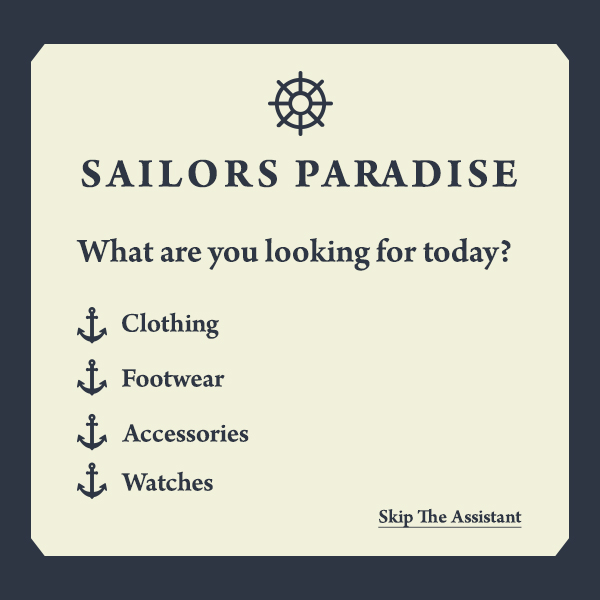
Here there is an option to skip this entire process of the use of AI in eCommerce is kept at the very start to not manipulate a shopper’s buying decision.
With this option, they can skip the entire Algorithm based process and directly start surfing the website on their own.
2. The next pop-up will depend on the shopper’s first selection. If he selected Clothing:

The selection on the second step completely nulls out all the options for women and does not bring up a single product tagged under ‘women’ section.
3. This third step then shows all the category indexing done under the ‘Men’s’ section:

Asking which type of clothing apparel are they looking for, further narrows down the search preferences to show optimum end results.
4. When the gentleman knows what he is looking for, the backend algorithm will then shed out all the bottom-wear and inner-wear tagged items. It will then look for all the items tagged under top-wear.
One thing to note even with the use of AI in eCommerce: Even though the filters on a website follows the same process, do not forget, users have to manually look for filters and apply them.
Here, however, the AI does all the work of understanding user preferences to display better results.
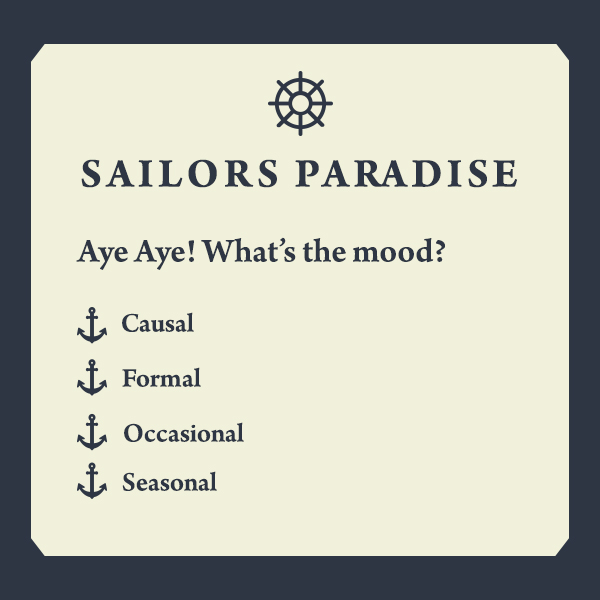
Also, the set of question designing will be in a way where the shoppers feel they are in fact interacting with a human assistant who is asking them questions.
Instead of cold, mundane words, the system will be designed to ask a personalized and warm set of questions.
5. The system will then determine the size a user is looking for. This will be a big relief for the shoppers as it will not show any size other than the one they are looking for.
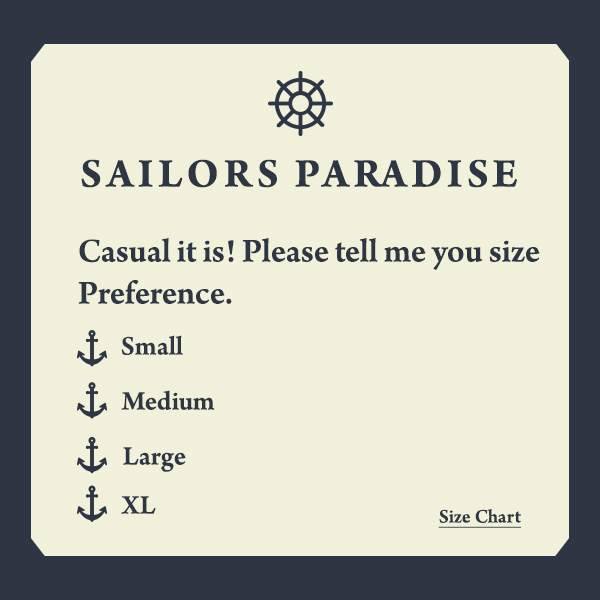
Once the size has been fixed, the algorithm can then bring up the results for the type of top-wear a shopper intends to buy.
In order to get a better understanding, this pop-up can include a size chart too.
6. Narrowing down further, a shopper can relax that he won’t be shown unnecessary results or products. He wants a Shirt and does not intend to look for a T-shirt thrown in between here and there. Does not want to see jackets and blazers lining up with the shirts.
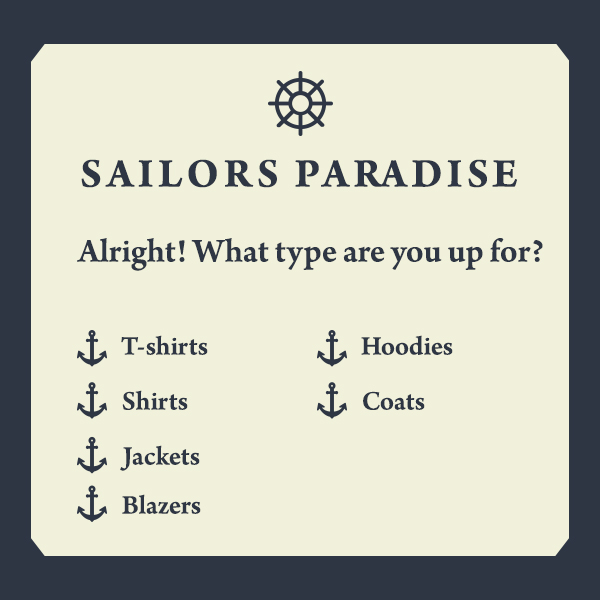
He knows it’s hot summer coming up and jackets would not interest him for the coming months. Hence,
7. He would not like a mixture of all the top-wear there exists displayed right there on his screen causing a great amount of confusion. If he would have selected ‘Seasonal’ option in the step number 4, all the items tagged under summer, winter, autumn or monsoon would show up in the next set of questions.
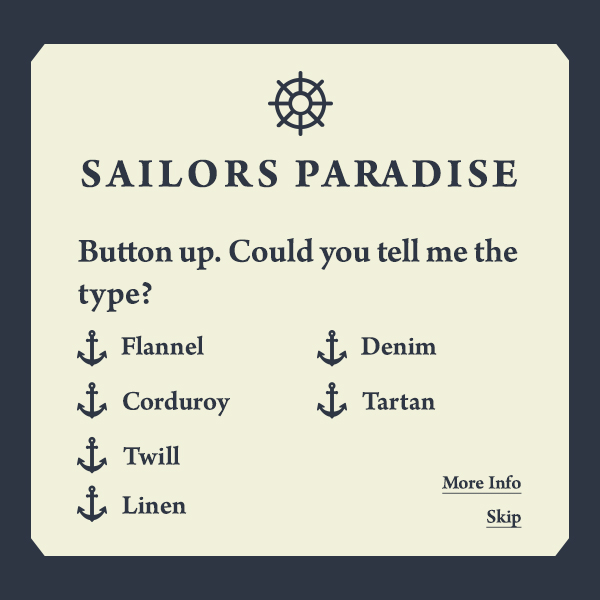
On this particular step, shoppers have the choice to select more options where they will be redirected to a page which contains all the types of shirts that are available.
This option can be useful if the shopper does not find his preference on the pop-up. And he can directly skip to the search results as well if he likes.
Here he will be shown all Casual Men’s shirts which fall under XL size. No further analysis will be there in this division. And, if he knows the type of shirts he is interested in,
8. The final pop-up will take him to the page which displays Men’s XL size casual Flannel shirts. Perfection at its best. These are the results that precisely reflects the shopper’s mood, preferences, opportunities, attitude, inclination, and emotions.

A tailor-made search result provider which justifies the decision-making ability of a human.
Points to remember
- Above points represent a hypothetical scenario. It does not signify or force the exact usage of algorithms. Each website caters to vivid categories of products. An algorithm will match accordingly.
- The number of pop-ups displayed with the use of AI in eCommerce depends on their selection of preferences by the user.
- They can anytime choose to skip the questionnaire and opt for manual shopping.
- The set of questions will appear again when a shopper returns to the website. This process will repeat every time a shopper comes on the site, regardless of the number of times they have visited.
A complete streamlining of the shopping establishes two things firmly,
i) Funneling of the shopper towards the end product they had in their mind means fewer browsers and more one-time shoppers.
All the customers who are just there for browsing or are researching are channeled right towards the product they were thinking about. This highly increases the chance of conversion.
ii) One-time shoppers or bargain hunters find it easy to get to the products. Eventually, this makes them product focused and addictive to the process.
The key to high conversion lies in channeling the customers quickly out of their initial phase and present them with the exact set of products they are looking for.
When they are shopping manually, there is an endless number of distractions which can get them off the track.
And sometimes, this contaminates their decision resulting in no conversion or abandoned cart.
A bespoke ‘Virtual Shopping Assistant’ removes all the possible distractions, keeping the shoppers on the right track throughout their shopping experience.
Over To You
TRooTech has absorbed and identified the eCommerce ecosystem and our management understands the working mechanisms.
By introducing the use of AI in eCommerce, another feather will be added to its cap.
Get your wheels in motion and put your eCommerce business on the fast track with this concept.
Follow Us On

